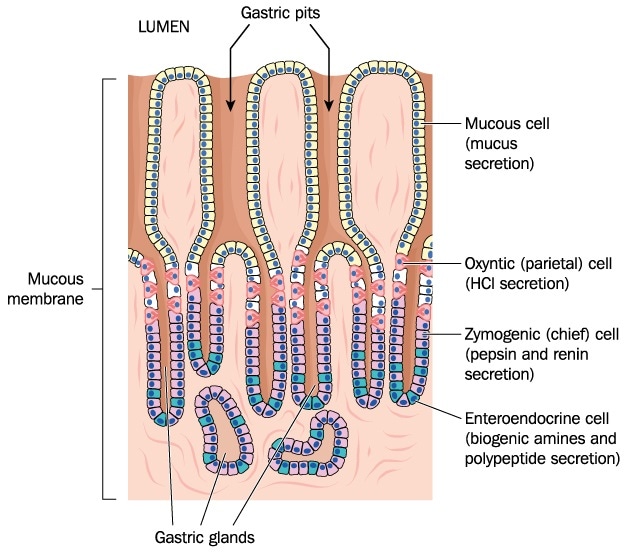Enteroendocrine cells are specialized cells found within the gastrointestinal tract, stomach and pancreas. They produce and release hormones in response to a number of stimuli. The hormones may be released into the bloodstream to generate systemic effects or may be distributed as local messengers. They may also stimulate a nervous response.
Enteroendocrine cells in the intestinal epithelium are the most abundant form of endocrine cell in the body, despite them only making up 1% of that epithelium.
Enteroendocrine cells respond to nutrients within the intestine by producing more than twenty peptides. Depending on their location in the gut, the cells release an array of peptide hormones that act locally on nerve endings and cells in the intestinal lining. They also act on organs elsewhere in the body such as the pancreas.

Gastric pits and glands, plus secretory cells of the stomach lining. Image Credit: By Blamb / Shutterstock
Traditionally, researchers have studied enteroendocrine cells to explore their roles in aiding adequate post-prandial absorption and digestion of food and nutrients. The main function of these cells is the sensing of nutrients within the intestine and enabling of ideal conditions for absorbing a given nutrient. For example, the enteroendocrine L-cells found in the duodenum undergo membrane depolarization when they sense long-chain fatty acids. This results in the secretion of cholecystokinin, which is required for fat digestion.
On binding to its receptor, cholecystokinin triggers contraction of the gall bladder and secretion of the pancreatic enzymes that are required to absorb and digest these fatty acids. Hormones secreted as a result of enteroendocrine sensing can also end eating by causing satiation within brain areas involved in feeding.
Aside from their role in nutrient sensing, enteroendocrine cells can also recognize and react to pathogens as a result of toll-like receptor expression and to microorganisms in the intestine through the expression of receptors that are specific to metabolites produced by commensal bacteria. On detecting pathogens and microbes, these cells supply hormones and cytokines to nearby immune cells. Immune cells also possess many peptide hormone receptors that directly modulate the immune response.
The hormones secreted also signal to afferent fibers of the vagal nerve to stimulate the release of acetylcholine, which stops nearby immune cells having anti-inflammatory responses. This signalling also modifies feeding pathways to change fat deposition, which then influences the amount of adipokines, such as the hormone leptin, released by fat cells. One role of leptin is to regulate the function of immune cells.
Many clinical trials have assessed enteroendocrine peptide receptor agonists as agents in the treatment of obesity and metabolic disorders. The cross-talk between enteroendocrine and immune cells is also a significant area of study among researchers interested in identifying potential targets for the treatment of intestinal infections and inflammatory disorders.
Further Reading
Last Updated: Feb 26, 2019